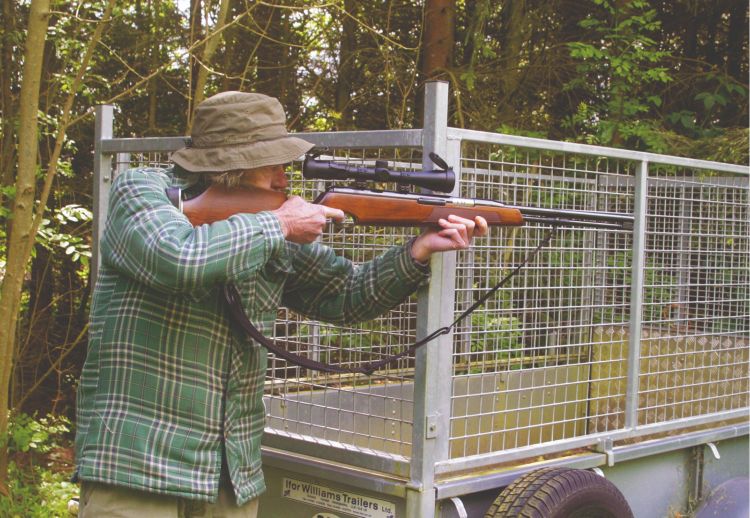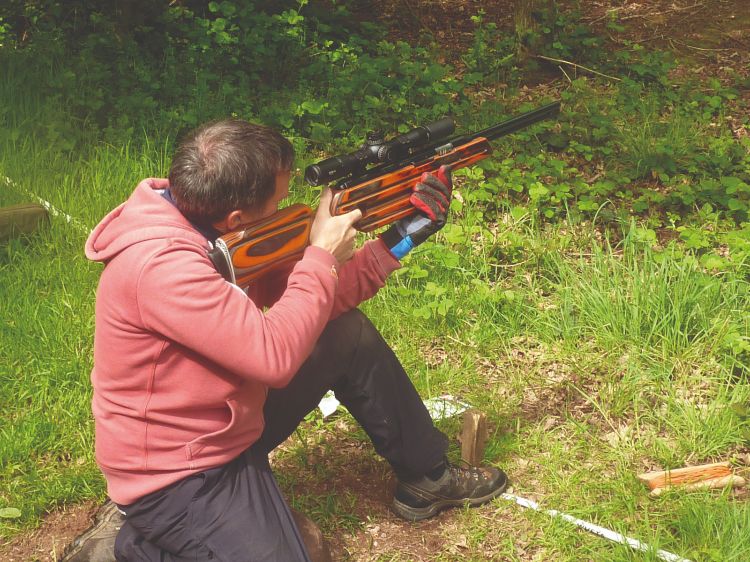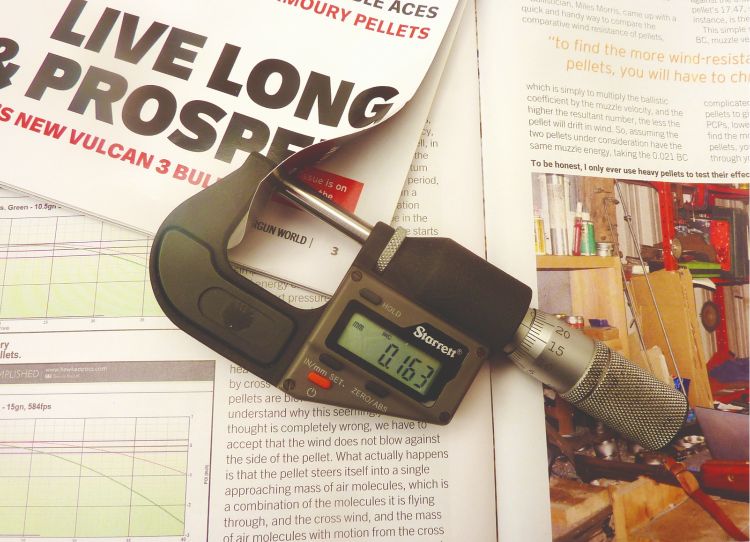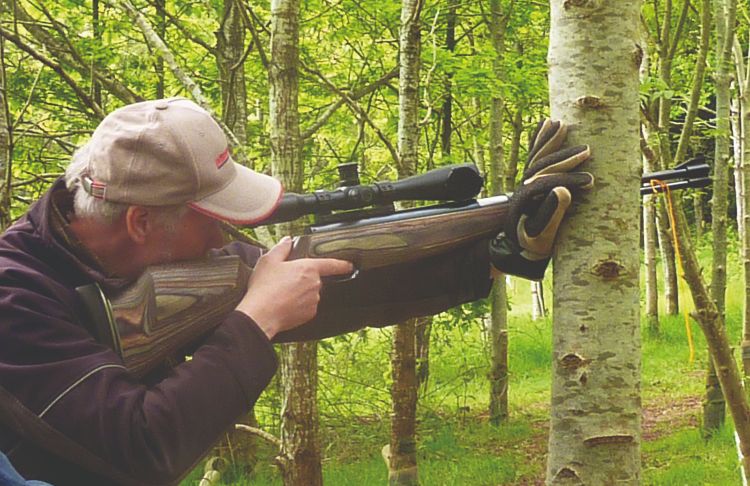The recoiling spring/piston air rifle is almost certainly the most difficult of all types of rifle to shoot accurately, because of its unique recoil cycle, and to understand why, we need to look at the differences between the recoil cycles of powder burners and springers, starting with energy.
In the firing cycle of a power burner, the recoil is predominantly the rifle’s response to the bullet’s mass being violently accelerated up the barrel, and it can be quite ferocious with heavier calibres. I used to own a .243 centrefire rifle (a deer/fox rifle not especially noted for the ferocity of its recoil) and hated using it, due to the recoil, which was roughly on a par with my 12 bore shotgun. Recoil can be expressed as kinetic energy, and my .243 recoiled with something between 8.5 and 9 ft.lbs., which is much more than the recoil energy of my TX200.
The peak recoil velocity of my TX200 is 2.67fps, and its mass with a scope is 4.6 (kg) x 2.2 x 7000 grains, which is 70840 grains, Plugging those figures into the formula for muzzle energy (velocity squared x weight / 450240) gives a peak recoil energy of 1.12 ft.lbs., so the recoil energy of the springer is around an eighth that of my .243, and we can conclude that the extra difficulty of shooting a recoiling springer is most certainly nothing to do with the recoil kinetic energy.
Another aspect of recoil is its acceleration. My TX200 takes a leisurely 9.4 ms (milliseconds) to push the piston to the end of its compression stroke – which is what causes springer recoil – whereas the centrefire recoil due to the bullet’s progression up the barrel is over in something between one and two milliseconds, so the centrefire’s recoil acceleration is many times fiercer, and so the extra difficulty of shooting a recoiling springer can have nothing to do with recoil acceleration.
However you measure it, the spring-piston air rifle recoil is a pussy cat compared to my centrefire, so the reason why the springer is the more difficult to shoot must lie elsewhere, and it is not the amount of recoil, so much as the nature of the recoil.
 Back And Forth
Back And Forth
After the trigger sear releases the piston in my 85mm-stroke TX200, the spring accelerates the piston for about seven milliseconds up to around 45fps, then the rising cylinder air pressure turns the acceleration into deceleration, and just after 8 milliseconds into the compression stroke, the 8.4gn pellet starts to move; at 9.4 milliseconds the piston comes to a stop, and the pellet is in the region of 4” up the barrel. When the piston comes to a stop, the recoil stops, and the forward surge begins, but in the centrefire, when the recoil stops, the bullet is probably already a hundred yards or more downrange, while the airgun pellet is still in the barrel, which has now reversed direction, and this is where shooting the springer gets tricky.
I have measured the recoil cycle of many springers, and the actual travel of some, the distance by which the rifle recoils and surges, varies from around 3.5mm recoil and 0.75mm of surge from a TX200 with the cylinder sleeved to 22mm and a lightweight piston, to over 7mm of recoil and around 1mm of surge from a much lighter break-barrel, and anecdotal evidence from America suggests that some of the ‘magnum’ springers can recoil by 15mm or more. The recoil travel of a springer is fairly consistent regardless of the pellet, but the surge varies hugely according to the pellet, although happily, the bulk of the surge occurs after the pellet has exited the muzzle.
The recoil travel of my TX200 with 85mm of stroke and shooting 8.4gn Air Arms Field pellets is just over 4.5mm, and the forward surge travel at the point of pellet exit is 0.16mm. After pellet exit, the surge continues for about a further 0.7mm, before reversing again into recoil as the piston travels forward the second time.
 Hold Sensitivity
Hold Sensitivity
The term ‘hold sensitivity’ describes the magnitude of changes in pellet point of impact (POI) according to how the rifle is supported/restrained, and all recoiling spring/piston air rifles are hold-sensitive to a degree, depending mainly on the amount of recoil travel, and the severity of the initial recoil acceleration.
The amount of rearward recoil travel depends on the length of the piston’s compression stroke, the piston and spring weight, and the rifle weight. Although some people will claim that a rifle’s recoil has reduced following a basic tune, the reality is that, unless the compression stroke has been reduced, the piston lightened, and/or the rifle’s weight increased, the primary recoil travel will not have altered following the tune, and the owner’s perception of less recoil travel is all in the mind, or a misinterpretation of a reduction in vibration/spring noise.
Mild tuning modifications might not significantly alter the primary recoil travel, but they can alter its nature, and I’m a fan of the gentle recoil acceleration that comes from using a low-rate spring with a lot of preload, whilst some favour the more rapid acceleration that comes from using a higher rate spring with little preload. I have a suspicion that rapid recoil acceleration can sometimes contribute to hold sensitivity, but that’s no more than a suspicion at present. It is without a shadow of a doubt the two-way recoil of the springer that makes it difficult to shoot, so how can we cope with it?
 Prescriptive
Prescriptive
In the early days of Airgun World, I remember reading articles about shooting technique which, as most were written by accomplished paper or bell target shooters, informed me that to shoot standing, I needed to master the same technique as said target shooters; namely, that my leading hand should support the fore end at the rifle’s point of balance, and that my upper leading arm should be rested against my chest. This was the right way to shoot off-hand, and anything else was wrong. Problem was, it didn’t work if shooting up into a tree, or down into a gulley, or if you were standing on sloping ground, and in fact, it did not work for me – full stop.
Before looking at what did work for me, let’s recognise that the point of balance of a recoiling springer is in one respect the very worst place to support it because, in addition to recoiling back and surging forward, the rifle wants to pivot around its centre of balance, the muzzle rising as the rifle recoils, falling as the recoil turns to surge, and supporting the rifle at its point of balance exacerbates the rise and fall, which in turn can increase hold sensitivity on those occasions when the terrain or angle of the target don’t let you adopt the ideal stance.
What actually worked for me was to support the fore end as far forward as was comfortable, which usually worked out to be where the front stock screws were, which is handy, because the single most important thing about supporting the fore end is that it is in exactly the same place shot after shot, and positioning my thumb and forefinger against one or both fore end screws helped to make this happen.
Supporting the fore end near the front reduces the rifle’s natural wish to pivot during the recoil cycle, and in fact, when I am shooting my TX200 from the bench, I am aware that the recoil is far more straight back than if the fore end is supported further back, and the aim point remains within the 15mm kill zone throughout the recoil cycle, whereas if the fore end is supported further back, the aim point inevitably ends up above the kill zone.
 Different
Different
We all differ to a degree in our build, and some might struggle to reach the front of the fore end, and the solution is to find what works best for you, and stick with it, regardless of what anyone else advises, because what works for them might not work for you. The best example of finding what works involved my HW77 back in 1985, which was far too heavy for my then nine stone frame, and I found that what worked for me with unsupported standing shooting broke all the rules. I did not use the ‘target’ stance, but held the fore end where the stock screws were, and I pulled the rifle back into my shoulder to help take its weight off my arms, which was a big no-no according to received wisdom, which was and still is that the rifle should be cradled and allowed to recoil as it wants.
These days, the vast majority of my shooting is from the bench, and I do not restrain the rifle in any way, resting it on my leading hand with the recoil pad only lightly touching my shoulder. The routine is, acquire target, find second stage of trigger pull, then take shot, and here again I differ from my old standing shot routine, because I could not hold the rifle on target whilst trying to feel for the second stage of trigger pull, and moved the blade through both stages of pull in a single movement. So it was that I broke just about every rule of shooting recoiling springers, but I’ll tell you this; it worked for me.
Follow-through
It may seem strange, but one of the most important parts of the shooting cycle occurs after the pellet has left the barrel, and it is ‘follow-through’, which most interpret as simply keeping the rifle pointing at the target, but there could be more to it than that. I advise people to make an effort to focus their attention solely on the reticle aim point and the target throughout the shot cycle, and after, and the reason is that the entire recoil cycle is over in less than the blink of an eye.
We may not be aware of it, but we blink spontaneously every two to ten seconds, and we also blink in response to external stimulus, which can include the recoil cycle. The recoil cycle to pellet exit is typically in the region of 11ms, and the rifle might be in motion for perhaps 35ms to 50ms while the spring settles down, but blinks can vary from 100ms to 400ms, so if you blink at the start of the recoil cycle, you won’t see any of the recoil cycle, and I believe many people do blink, without being aware of it. As the trigger is pulled, the crosshairs are on the target, and by the time a blink has ended, the crosshairs are usually a little higher, and our brain cleverly fabricates the missing visuals, so we are blissfully unaware that we did not see the target during the recoil cycle.
By focusing our attention on the reticle and target during the shot cycle, we tend not to blink, and we can see any technique issues that might send the pellet astray, mainly pulling the rifle to one side while pulling the trigger. That’s why follow-through is so important.
Shooting springers is very challenging, but that gives a real sense of accomplishment when the pellet hits the mark, and that’s the attraction of the springer.